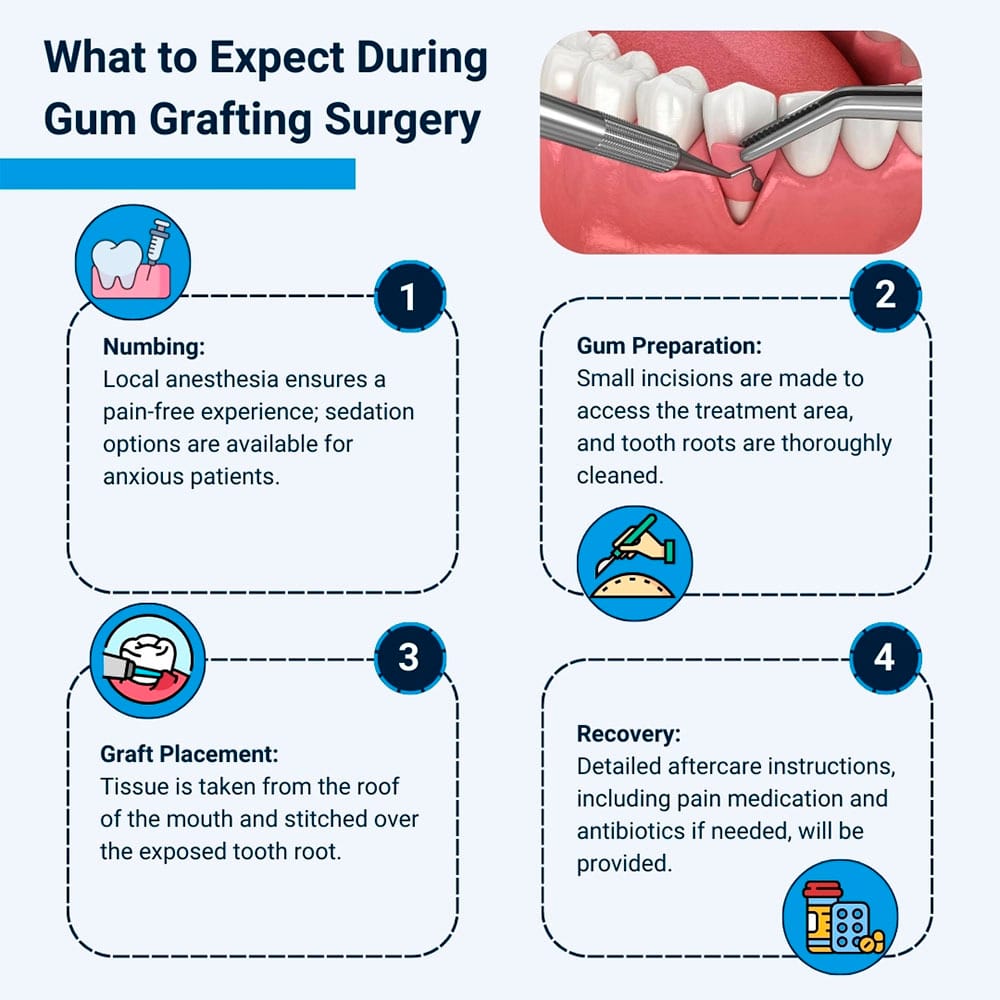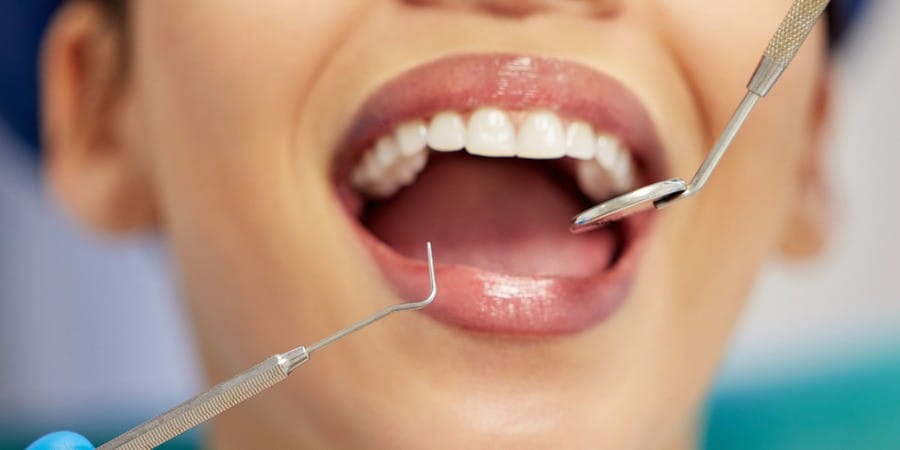This article explains more about gum grafting, the type of gum grafts available, and what to expect if you need a gum graft.
What Is a Gum Graft?
A gum graft is normally carried out by a periodontist, a dental specialist with advanced training in treating structures around your teeth, including your gums. The process takes suitable material from another site in your mouth and grafts it over the areas where the gum is deficient.
A periodontist has first graduated from dental school before receiving several years of additional and more advanced training, focusing on this dental specialty.
Read more: Do You Need a Root Canal? Seven Telltale Symptoms

Why Would I Need a Gum Graft?
It might be recommended that you have a gum graft if you have significant gum recession. Often, receding gums are a symptom of severe gum disease, another condition that a periodontist can successfully treat. However, there are other reasons why you may need a gum graft.
Some people will need a gum graft because they brush their teeth too aggressively, especially using a hard-bristled toothbrush. Applying too much pressure when brushing your teeth can wear away your gums, causing them to recede.
Other people may have genetically thinner gum tissue and need to increase the volume of their gums to improve oral health or in preparation for other treatments like dental implants.
How Will I Know If I Need a Gum Graft?
The first stage is to see a periodontist for a dental exam. They must check the condition of your gums, ensure you don’t have any signs of active periodontal disease, and they will assess the degree of gum recession around each tooth.
If your periodontist determines a gum graft is the best treatment, they will discuss which type of gum graft procedure will provide good results. Several types are available.
Read more: 5 Tips for a Fast and easy Post-Gum Graft Recovery
Connective Tissue Gum Graft
A connective tissue gum graft is the most common graft used to cover exposed tooth roots. In this treatment, a small flap of skin is created in the roof of your mouth, called the palate. Your periodontist removes a small amount of tissue from underneath the flap. This issue is called sub-epithelial connective tissue.
Once the tissue is removed, your periodontist will stitch it around the exposed tooth root, covering it up. The flap in the roof of your mouth is also stitched shut.
Pedicle Graft
A pedicle graft is only used in certain circumstances, as the gum grafting material is taken from a nearby gum. There needs to be plenty of healthy gum tissue nearby for it to be successful.
During this procedure, your periodontist creates a flap called a pedicle from a gum near the exposed tooth root. One end of the flap is left attached to the gum. Once the pedicle is created, it is pulled across to cover the exposed tooth root and stitched into place.
Free Gingival Graft
A free gingival graft is another graft taken from the roof of your mouth. However, instead of creating a flap, your periodontist will remove some tissue directly from the surface of the upper palate.
Once the tissue is removed, it is stitched into place. A surgical dressing can be placed over the donor site in the roof of your mouth to protect it during healing.
You may be recommended to have this type of graft if you have naturally thinner gums and require more gum tissue to increase their volume.
Read more: Metal Crowns vs. Porcelain Dental Crowns
Substitute Gum Grafting Material
Most times, the gum grafting tissue is taken from your mouth. Occasionally, a periodontist might wish to use a substitute material instead. This would be supplied by a reputable tissue bank and is extensively tested and sterilized to ensure it is safe for use.
What to Expect During Gum Grafting Surgery
The steps involved with surgery are outlined below, but your procedure may be slightly different since it will be tailored to your needs.
Numbing Your Mouth
Your treatment should be pain-free as your periodontist will numb your mouth before they begin this procedure. If you wish, ask about sedation dentistry, which can be helpful for anyone who is a bit more nervous or anxious about this treatment. Many periodontal offices offer these services.
Preparing Your Gums
Once the anesthesia and sedation take effect, the surgery site is carefully prepared. The periodontist will carefully make a small incision into your gums to access the area needing a gum graft. Your periodontist will thoroughly clean the tooth roots that will be covered with the grafts.
Removing the Gum Graft Tissue
Another incision is made in the roof of your mouth so a small section of tissue can be removed. The site is closed with stitches; your dentist may place a surgical dressing to protect it.
Placing the Gum Graft
Once the gum graft is removed, it is placed over the tooth root and stitched into position. Your gum tissue is then replaced and stitched back in position.
Recovering after Gum Grafting
After surgery, your periodontist will keep you in the dental office until they are sure you can safely go home, especially if you received sedation dentistry. They will provide you with detailed after-care instructions.
Your after-care package may include a prescription for pain medication or antibiotics. If so, you should take them as prescribed.
How Long Will Recovery Take?
Most people find recovery only takes one or two weeks. If you had multiple gum grafts, then it could take a bit longer. Your periodontist can give you a better idea of healing times when you see them.
Below is an idea of what to expect for the first few days after surgery.
The First 24 Hours
Feeling some minor discomfort, bleeding, and swelling after gum grafting is perfectly normal. Ensure you get plenty of rest and don’t do anything too strenuous.
Follow your periodontist’s instructions on keeping the surgical site clean. You may need to use an antibacterial mouthwash as you won’t be able to brush or floss near the gum graft initially.
You should, however, brush and floss your other teeth if possible.
Choose soft, cool foods that don’t require chewing, such as smoothies, yogurt, or ice cream.
Week One
You should find any bleeding stops within the first 24 to 48 hours, but the surgery site may continue to feel swollen for 3 to 4 days afterward. You may have some bruising, and this is perfectly normal. Keep taking any prescribed medications.
When you feel able, you can begin eating a wider choice of soft foods like well-cooked vegetables, scrambled eggs, fish, and pasta.
Continue brushing the rest of your teeth normally, but avoid brushing near or around the gum graft. You shouldn’t begin brushing here until your periodontist has advised it is safe.
Week Two
By this stage, your gums should feel much more comfortable, and any bruising and swelling should have begun to subside nicely. You should feel comfortable enough to eat more solid foods. However, avoid eating anything very hard, spicy, or crunchy until your periodontist tells you it’s safe to do so.
Read more: The Pros and Cons of a Dental Bridge
Is Gum Grafting Safe?
Gum grafting is a routine procedure that is generally very safe and free from complications. However, there is always a small risk that something could go wrong. These risks could include infection or uncontrolled bleeding. Sometimes, gum grafts can fail.
Is It Worth Having a Gum Graft?
Yes, if your periodontist advises it, as it can provide several benefits, including:
- Decreasing tooth sensitivity.
- Improving the aesthetic appearance of your teeth.
- Reducing the risk of oral diseases, including tooth decay and gum disease.
When you see your periodontist, they can discuss this procedure in more detail and explain all the risks and benefits of treatment.

